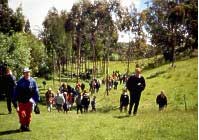|
|
|
Other definitions of farm forestry
and agroforestry

Definitions of farm forestry and agroforestry
vary both in Australia and overseas. The choice of definition
can influence the allocation of funding, the identification
of research priorities, and the development of policies and
programmes. Below are just some of the definitions adopted
by Australian government and industry groups.
Australian Forestry Council (1980)—Federal
Government Advisory Group
Agroforestry: " …
the deliberate management of forests for simultaneous production
of wood and agricultural products."
Victorian Joint Agroforestry Management
Committee (1991)—Victorian Government Advisory Group
Agroforestry: " …
a system of sustainable land management that involves the
integration of forestry and agriculture on the same land unit."
Australian Forest Growers, Greening
Australia, National Farmers Federation and National Association
of Forest Industries Joint Statement (1997)—industry
groups
Farm Forestry: "
… the growth and management of trees on farms, as part
of the farm enterprise, for the purpose of producing wood
and/or non-wood products."
National Farm Forestry Program—Australian
Government funding program, 1995–2000
Farm Forestry: " …
the incorporation of productive tree growing into farming
systems. It improves agricultural production by providing
shelter for stock and crops. It also provides substantial
environmental benefits such as water table and salinity reduction."
National Farm Forestry Roundtable
(1999)—Federal Government Advisory Group
Farm Forestry: "
… incorporation of commercial tree crops into farming
systems to complement conventional agriculture with new products,
as well as provide a capacity to enhance agricultural productivity
and achieve better resource management."
NSW Department of Land and Water Conservation
(1999) Cole-Clarke
"Agroforestry,
is strictly speaking, the production of a timber product and
an agricultural product from the same parcel of land."
Agriculture Fisheries and Forestry,
Australia (AFFA)
"Farm forestry is the incorporation of commercial tree
growing into farming systems and includes plantations on farms.
It takes many forms, including timber belts, alleys and widespread
tree plantings. Farm forestry can provide farmers with an
alternative source of income. It can also provide substantial
environmental benefits such as salinity control.
AFFA use the following diagram developed by Miles Prossor
(1995), who at the time worked for he National Association
of Forest Industries (NAFI), to illustrate its definition
of farm forestry.
.gif)
Federal Research and Development Corporation’s
(RDC’s) Joint Venture Agroforestry Program
Agroforestry: "
… the productive use of trees on farms. Agroforestry
has the potential to improve agricultural productivity, diversify
and increase farm income, conserve land, maintain biodiversity
and contribute to the national timber supply."
Western Australia CALM and AgWA
Agroforestry: "The
integration of trees with other agricultural enterprises on
a farm. The combined profit from forest and agricultural produce
can exceed the profit from either alone. Trees are typically
planted as timberbelts, shelterbelts, alleys or woodlots."
Farm Forestry: "Commercial
tree production on farmland."
NRE: Farm forestry/agroforestry—What
is it? Charles Hajek
Farm Forestry: "This
is the management of trees for a commercial purpose. Typically
this is timber plantations on private land. However it can
be applied to a whole range of enterprises utilising different
parts of the tree and managed in a variety of ways."
Agroforestry: "This
is the combining of agriculture and tree growing so as to
produce both agricultural products and tree products on a
commercial basis. The purpose of this is to gain positive
interactions between the two systems at both the paddock level
and the enterprise level. "
Greening Australia
Farm Forestry: "Farm Forestry is the
management and use of trees on farms for commercial purposes."
INTERNATIONAL DEFINITIONS
USDA National Agroforestry Centre
Agroforestry: "
… intentional combinations of trees with crops and/or
livestock."
The USDA defintion suggests that there are five basic types
of agroforestry practices: " … alley cropping, windbreaks,
riparian buffer strips, silvopastoral and forest farming."
Agroforestry systems are more " … integrated, diverse,
productive, profitable, healthy and sustainable land-use systems."
The following site provides excellent examples including photographs
of each of the agroforestry types identified by the American
researchers: http://agebb.missouri.edu/umca/
International Council for Research
into Agroforestry (ICRAF 1982)
References: Lundgren, B.O. (1982) ‘What
is Agroforestry?’, Agroforestry Systems, 1(1), pp. 7–12
Agroforestry: " …
a collective name for land use systems and technologies where
woody perennials are deliberately used on the same land unit
as agricultural crops and/or animals, either in some form
of spatial arrangement or temporal sequence. In agroforestry
systems there are both economical and ecological interactions
between the different components."
International Council for Research
into Agroforestry (ICRAF 2001)
References: ICRAF www site: http://www.ciesin.org/IC/icraf/ICRAF.html
Agroforestry:
"Put simply, agroforestry is using trees on farms."
ICRAF now defines agroforestry as:
" … a dynamic, ecologically based, natural resource
management system that, through the integration of trees on
farms and in the agricultural landscape, diversifies and sustains
production for increased social, economic and environmental
benefits for land users at all levels."
Back to top
|
